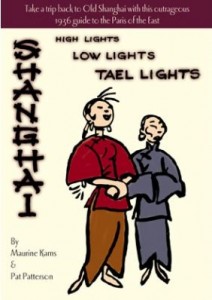
This guide about old Shanghai newly re-published by Earnshaw books is surely not politically correct. “Shanghai high lights, low lights, tael lights” is was not really a guide about Shanghai like “All about Shanghai“. Instead, it is an insight into the life of two Westerners living the high life of drinking and partying like no tomorrow. As they write it, they “know very little about [Shanghai], but know a hell a lot about that very little”. They clearly lived in a very small part of Shanghai and clearly had a kind of high life.The book is short, opinionated and quite funny in its description of the city.
“Shanghai is a grand town, not an atmospheric background for Oriental melodrama, but a grand place to live, to work and enjoy life”. Just like in other guides, the author surely makes fun of the foreigners and tourists coming to Shanghai looking for their imaginary China with pagoda’s, temples, obscure old monks holding eternal secrets and all the “magic of the orient”. They have no interest in tourist spots of the day (and still of today) like “Lung Wha Pagoda” and the “Willow Pattern Tea House” (Yu Yuan garden area): “As a matter of fact, all of these and others of their type, are a distinct bore”. What they point to instead are modern places where Chinese gather for entertainment, such as the “Great World Amusement Company” (on Xi Zhang lu, currently under re-construction), Wing On, Sincere and the other department stores on Nanking Road (today Nanjing Dong Lu). They also spend many pages on street life, vendors and other common sights that are not far from today’s Shanghai.
Since they spent a lot of time going out and enjoying nightlife, this is the main focus of the book. The leading spots of the time were “the tower, atop the very gilt-edge Cathay hotel” (today Peace hotel is under renovation, but surely another bar will open on the top of it. This just a few meters from today’s Bund 18). “the Sky Terrace, atop Park Hotel and the Paramount Ballroom“. The author then moves onto Chinese cabarets (somewhat equivalent to today’s Chinese night clubs). After parties locations like the infamous “Venus Cafe” in Hong Kou district gets a few pages, reminding me of my last visit to Dragon Club in after party… 3 or 4 years ago. My preferred part is surely the one explaining the “three ways of making whoopee in Shanghai”, i.e. three ways to party. “Number one is by sending the boy out for three quarts and some ice, and telephoning Clara and Dick to come over and lift a few. This is known as ‘going to town while remaining at home’. Then there’s the business of gathering the clan and making the spots, St Georges, Del Montes,etc and is known in some quarters as ‘going to the dogs’. Can be expensive. And last, there are those who in case themselves in silk and white linen and sally forth to places of the cover charge type, the only real difference between this and the last class being that it takes them longer and more money to feel their liquor. This is known, (by people in the second class) as ‘going highbrow’ and can be extremely expensive financially, coming under the heading of ‘major appropriations’.”
Although the guide was written more than 70 years ago, the life of its writers was not very different from a number of people I know in Hong Kong who rarely live Central or the South part of the Island and party just the same way… or people I know in Shanghai who live work and party in an area which is just slightly bigger than the one described in the book. The modern version of this book would be an un-expurgated compilation of smartshanghai.com forum focusing on only on Shanghai’s nightlife for singles. In Shanghai, some things never really change.